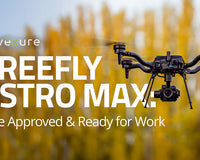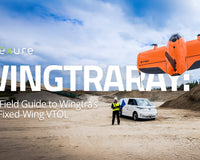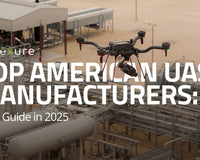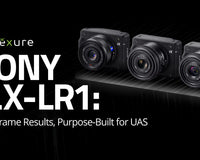From remote acres of farmland to crowded city streets, drones are transforming how we collect data, respond to emergencies, and maintain critical infrastructure. According to the Federal Aviation Administration (FAA), the commercial drone fleet in the United States could expand from just over 500,000 registered units to nearly 2.4 million by 2026. Globally, analysts predict the drone market will reach more than $63 billion by the mid-2020s, underscoring the technology’s explosive growth.
Amid this rapid expansion, regulatory frameworks and enforcement are still catching up, especially around beyond visual line of sight (BVLOS) operations. For many drone programs BVLOS represents the future of efficient autonomy and workflows. Yet, it also raises new questions about airspace safety.
That’s where Detect and Alert and Detect and Avoid technologies come into play. These systems are quickly becoming indispensable for reducing collision risk and bolstering confidence in remote drone operations
However, not all solutions are created equal. Understanding the distinction between Detect and Alert and Detect and Avoid is an essential consideration when investing in detection systems for BVLOS operations. Let’s dive into the differences.
Understanding the Basics: Detect and Alert vs. Detect and Avoid
Detect and Alert vs. Detect and Avoid
When it comes to mitigating mid-air collisions, there are two core methodologies: Detect and Alert (D&A) and Detect and Avoid (DAA).
In a Detect and Alert setup, the system identifies potential hazards—often via radar or optical sensors—and sends an alert to the operator. An example is Casia G from Iris Automation, which relies on ground-based optical nodes to monitor the skies and notify the remote pilot of incoming aircraft, or MatrixSpace 360 Radar, which actively scans the airspace and sends real-time alerts. Much like a car’s backup sensor that beeps when you’re too close to an obstacle, these solutions provide critical awareness but ultimately depend on human intervention for evasive action.
On the other hand, Detect and Avoid systems, such as the Casia onboard suite, take autonomy a step further. Rather than just alerting the pilot, the aircraft itself can maneuver away from danger in real time. Think of it as a self-driving car that not only warns you of nearby objects but also steers to avoid collisions. This autonomous capability significantly reduces response time and is especially useful when operating BVLOS, where a pilot may not see hazards visually and communication lag could compromise safety.
Cooperative vs. Non-Cooperative Detection
Non-cooperative detection uses sensors such as radar, acoustic arrays, or optical cameras to spot aircraft not emitting signals. While cooperative technology is more reliable when other aircraft actively share their positions, non-cooperative methods are crucial for capturing “stealth” obstacles that don’t broadcast their whereabouts.
By combining both approaches, DAA systems can offer robust, 360° situational awareness—an essential foundation for confident BVLOS operations.
Regulatory Deep-Dive: How Drone Detection Supports BVLOS
Under FAA Part 107, a key requirement for drone operations is maintaining visual line of sight—or having a visual observer (VO) if the pilot can’t directly see the aircraft. This human-centric approach ensures safety but can be resource-intensive and isn’t always 100% reliable.
Studies show visual observers often struggle to accurately judge distance and altitude, particularly when identifying small, low-noise aircraft like paragliders or non-cooperative UAVs. Misjudging available response time, for instance, could delay evasive maneuvers—exactly what BVLOS aims to avoid.
Because of these inherent limitations, regulators are increasingly looking to D&A and DAA solutions to fill the gap. The FAA has introduced waivers that reduce or remove the VO requirement if an operator demonstrates a reliable detection system. One way is by operating close to the ground or structures—commonly called “shielding”—but for truly unrestricted BVLOS, the drone must have an onboard or ground-based DAA mechanism to autonomously or semi-autonomously detect and steer clear of potential conflicts.
Several drone programs in the U.S. have already obtained BVLOS approvals by integrating both cooperative and non-cooperative detection methods, reducing their reliance on VOs.
The FAA's willingness to grant these approvals highlights a fundamental shift: no longer is BVLOS purely theoretical, but a practical reality when robust detection systems are in place.
Even so, regulators require clear operational mitigations if the detection system fails—redundancies or contingency procedures must be documented and proven safe.
How Detect & Alert and Detect & Avoid Systems Work
At the heart of any collision-prevention setup is a blend of sensors and data-processing algorithms designed to spot potential hazards and respond accordingly.
On the Detect and Alert side, solutions like MatrixSpace 360 radar or Casia G (a ground-based optical system from Iris Automation) deliver real-time visibility of the airspace to the remote pilot. Radar actively emits signals and reads the reflections to detect intruders—cooperative or non-cooperative—within its coverage zone. Ground-based optical sensors, on the other hand, rely on cameras and computer vision to continuously monitor for incoming traffic. Whenever these systems perceive a risk, they issue an alert to the operator, leaving the final avoidance maneuver to human discretion.
Detect and Avoid (DAA) technology automates that final step by handing collision-avoidance decision-making to the aircraft’s onboard systems. For instance, Casia Onboard from Iris Automation uses electro-optical cameras to achieve a 360° field of view around the drone. These visuals feed into an AI-powered processor that calculates where intruders are, how fast they’re moving, and where to steer in order to avoid a conflict. This capability is akin to a car’s self-driving feature—rather than just warning you to brake, it physically takes action, making DAA more proactive than purely alert-based solutions.
Active vs. Passive Sensors
- Active Sensors: Radar is a prime example. By transmitting radio waves, it can detect objects even under low-visibility conditions. However, radar can require regulatory approvals (like FCC certification), add weight, and increase power draw—key considerations for drone deployments.
- Passive Sensors: Optical or acoustic sensors simply observe existing signals, like light or sound. Because they don’t transmit, they usually don’t need special licensing. Ground-based optical systems and onboard camera arrays fall into this category.
Onboard vs. Ground-Based
- Ground-Based Systems: Easier to maintain and can be networked together for large-area coverage. However, their effectiveness depends on positioning and line of sight.
- Onboard Systems: Offer continuous protection regardless of flight location. The trade-off lies in weight, power consumption, and integration complexity.
Taken together, these overlapping sensor technologies—whether ground-based or onboard—form the backbone of modern DAA solutions that pave the way for safer, more scalable BVLOS operations.
The Future of Drone Detection and Autonomy
As BVLOS operations evolve, the FAA’s Aviation Rulemaking Advisary Committee (ARAC) recommendations point toward more standardized requirements for Detect and Alert/Avoid solutions. Regulations may eventually lessen the reliance on one-off waivers, emphasizing a universal framework that integrates automated collision avoidance into normal drone flight. This shift will likely boost adoption of both onboard and ground-based DAA systems, especially for enterprise and public safety missions.
Another promising development is the rise of AI and edge computing in drones. By processing vast amounts of sensor data in real time—right on the aircraft—drones can make split-second decisions without waiting for ground-based servers. The result is faster, more autonomous collision avoidance and less lag for crucial tasks like object detection or flight path adjustments.
Finally, DAA and D&A capabilities will increasingly intersect with Counter UAS (cUAS) efforts, as security agencies and critical infrastructure providers use overlapping detection methods to identify both friendly and potentially hostile drones. These dual-purpose systems are already emerging, reflecting a broader industry push to unify safety and security solutions. Combined, these trends suggest a future where BVLOS flights become commonplace, powered by robust, AI-enabled detection systems that streamline regulatory approvals and enhance airspace safety.
Empower Your BVLOS Operations Today
While Detect and Alert solutions enhance situational awareness by notifying operators of potential hazards, Detect and Avoid technologies take a proactive stance, autonomously steering drones away from threats to ensure uninterrupted and secure flights.
At Advexure, we understand the complexities and demands of modern drone programs. Advanced detection systems are designed to empower enterprise and commercial users across sectors like public safety, utilities, agriculture, and more, enabling seamless BVLOS missions with enhanced safety and reliability.
Ready to elevate your drone operations with cutting-edge drone detection technology? Request a Quote today and let our expert team guide you toward achieving your BVLOS and enterprise drone objectives safely and efficiently.










